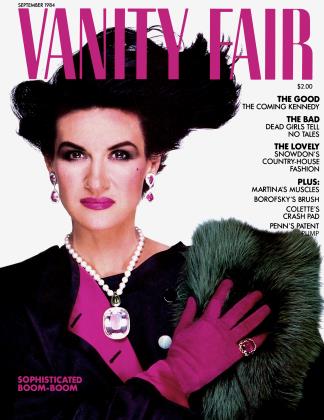Sign In to Your Account
Subscribers have complete access to the archive.
Sign In Not a Subscriber?Join NowDustin, Darling, Be an Angel
How pennies are pinched Off Broadway
WHEN Lanford Wilson’s play Balm in Gilead was previewing Off Broadway at the Circle Repertory Company theater this summer, John Malkovich, the play’s director, who was starring on Broadway in Death of a Salesman, invited Dustin Hoffman to a matinee performance.. At the time, the production was still undercapitalized by $70,000 as a result of a last-minute contractual dispute with a potential co-producer. But Dustin Hoffman loved Balm in Gilead. He loved it so much that he made a gift of $70,000 to Circle Rep to cover the deficit.
If it hadn’t been for Hoffman, Circle Rep would have sunk $70,000 even deeper into debt. This coming season, Off Broadway will see new plays by Wally Shawn, Tina Howe, Christopher Durang, John Guare, David Hare, Jonathan Reynolds, Michael Weller, Peter Parnell, and others. Linda Ronstadt will star in La Boheme at the Public Theater; Playwrights Horizons will stage a workshop of Wendy Wasserstein’s first musical, called Miami. Nobody knows whether these productions will be artistic successes, but it is a fact that they will all lose money.
The creative melting pot in the theater has long since transferred from Broadway to Off Broadway. On the other hand, the scramble for financing remains an ever present nightmare. Last year, eighty-six notfor-profit theaters produced 260 different plays on operating budgets totaling $45 million. As ticket sales bring in much less than half that amount, the balance is made up by grants from foundations, government agencies, corporations, and individuals. Still, at first glance, $45 million seems like a grand sum of money, even for so many plays. But a look at a budget for one of these productions gives new meaning to the phrase “stretch the dollar.”
Earlier this year I co-produced a play with the Second Stage, a new company which recently built its own theater at Seventy-sixth Street and Broadway (thereby giving it the paradoxical distinction of being an Off Broadway theater on Broadway). The play, called Linda Her and the Fairy Garden, was written by Harry Kondoleon and directed by Carole Rothman, who along with Robyn Goodman is responsible for the artistic direction of the company. The production budget for the play was $30,757—nothing to sneeze at—but by the time all was done this pic had been cut up into pathetic pieces. Consider the following:
Ten actors received a total of $5,875 for nine weeks of work. This means that each member of the cast, including the stars, Brooke Adams and Carol Kane, was earning $65.30 per week. The entire budget for technical staff, including stage managers, electricians, and wardrobe personnel, was $4,175. (The wardrobe designer made $500 for five weeks of work and had a budget of $ 1,000 to costume ten actors in the latest nouveau riche styles, a task made only slightly less difficult by one of the actors’ being able to appear in underpants.) Production costs for all costumes, sets, props, sound, trucking, etc. were $10,470. Our set budget of $6,720 was less than what the Shuberts normally spend on an opening-night party. The outlay for graphic design, posters, programs, and mailing was $2,960. The total advertising budget for A.B.C. listings in the New York Times was a whopping $240. The prop supervisor made $200 over five weeks and, if that were not insult enough, had to procure six pieces of wicker furniture, a bed, a fan, sheets, pillows, a birdbath, a marble railing, assorted crystal decanters, an entire English garden in full bloom, silver trays, plus a cornucopia of bric-a-brac on a budget of $650. The prop supervisor not only brought it all in on budget but did so with top-ofthe-line goods:
First, he approached a dozen different wicker dealers, offering a program credit in exchange for a five-week loan of the necessary furniture. He also guaranteed against damage. This offer left all merchants cold until one day he walked into Walter’s Wicker Wonderland, at Fiftysecond Street and Second Avenue, where he talked with a sales rep who, as it turned out, knew about the Second Stage because she had walked by the theater a few times. She convinced Walter, her boss, that a loan to the theater would be good for “community relations” even though Walter’s Wicker Wonderland was in fact nowhere in the same neighborhood as the Second Stage.
The next problem was to rent, borrow, or buy enough artificial grass, bushes, and flowers to fill one hundred square feet of upstage space. The prop supervisor's quest led him to a hospital where an artificial-flower merchant was recovering from back injuries. At bedside they agreed to $250. The only condition of this rental was that the merchant’s name not be used in the program credits, lest he earn a reputation for making rotten deals.
Finally, when Linda Her and the Fairy Garden was about to start previews, David Rabe’s new play, Hurlyhurly, directed by Mike Nichols and starring just about everybody you can think of, was preparing to open at the Promenade Theatre, which is in the same building as the Second Stage and shares the box office and lobby on the ground floor. Hurlyhurly had a large poster outside the theater which dwarfed our smaller one.
“Let’s blow up our poster so it doesn’t look like a postage stamp,” I said.
“It’s going to cost thirty-five dollars,” I was told.
“So?”
“It's not in the budget.”
We spent the thirty-five dollars anyway. Three days later the poster was stolen.
Tony Kiser
 View Full Issue
View Full Issue












Subscribers have complete access to the archive.
Sign In Not a Subscriber?Join Now